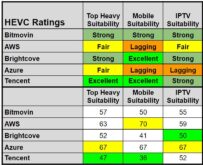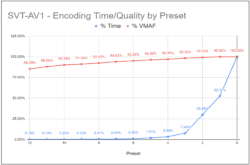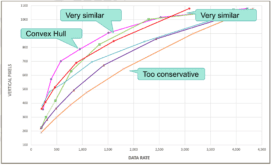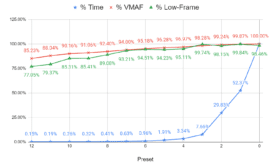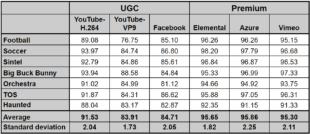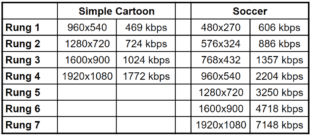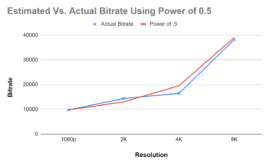The course Encoding with the AV1 Codec has been updated with new instructions for SVT-AV1 1.0 and FFmpeg/libaom-AV1. AV1 is a powerful codec but to optimize quality and performance, you have to choose the optimal preset and thread count and then navigate through obscure commands like auto-alt-ref, row-mt, tile columns/tile rows, and lag-in-frames. The course, Encoding with the AV1 Codec, provides …
Read More »SLC Releases Cloud-Based HEVC and H.264 Per-Title Quality and OPEX Reports
Choosing the wrong per-title encoding service can boost streaming costs by up to 64% and storage costs by 76%. It can also reduce the average video quality delivered to your viewers by up to 9.28 VMAF points. These reports identify the OPEX and quality leaders and save months of testing. Overview: Per-Title encoding is the most efficient and effective technology …
Read More »Choosing a Preset for SVT-AV1 (Or Any Codec)
This post explores the economic factors to consider when choosing a preset for the SVT-AV1 codec. It’s adapted from a new lesson added to the course, Encoding with the AV1 Codec. While this analysis uses the SVT-AV1 codec, it’s useful for choosing a preset for any codec. I’ve always considered codec preset selection a cost and quality-driven decision. You see …
Read More »How to Compare Per-Title Encoding Systems
I just completed the first of two reports on cloud-based per-title encoding features, culminating 8 months of work. The first report details H.264 output, and the next, scheduled for release by July 18, details HEVC output. This article will detail the procedures used during this analysis which will be helpful to any company seeking to perform their own analysis to …
Read More »SVT-AV1 and Libaom Tune for PSNR by Default
As of June 22, 2022, libaom-AV1 and SVT-AV1 tune for PSNR by default, and libaom-AV1 doesn’t appear to have a mode that optimizes actual video quality. Be sure to verify and consider this when comparing the codecs to others. Most of the time with codec experimentation, a lapse in attention costs you hours, days, or weeks of re-encoding and re-testing, …
Read More »SVT-AV1 1.0 Shows Great Promise
I’ve been testing SVT-AV1 1.0 for a presentation that I’m giving on open-source AV1 encoding alternatives at Streaming Media East on May 24, 2022. The results have been impressive; two-pass VBR encoding is working well, and the codec offers a great range of presets, with several much faster than real-time. In contrast, FFmpeg’s libaom-AV1 has no presets even close to …
Read More »Finding the Optimal Top Rung Data Rate
The top rung of your encoding ladder is the most expensive to deliver, and in many regions, it’s also the most frequently viewed. Encode at too high a bit rate and you’re wasting money; encode too low, and you’re potentially reducing viewer quality of experience. This makes choosing the top rung bitrate a key task for all streaming producers. This …
Read More »Per-Title Encoding 2022
My article, Buyers’ Guide to Per-Title Encoding is up on Streaming Media. Per-title encoding is one of the simplest and least expensive ways to reduce streaming bandwidth, increase viewer QoE, or accomplish both. It’s becoming a standard feature in cloud-encoding services. The article begins with an overview of what per-title encoding is and why it’s important. Then it compares per-title …
Read More »Encoding for Transcoding vs Encoding for Distribution
A consulting client sent the following command string for a 1080p file they were encoding for upload to Vimeo, their online video platform. crf=20:vbv-maxrate=10000:vbv-bufsize=9500 What’s wrong with these parameters? First, some theory. One distinction to understand when encoding files is the difference between producing a mezzanine file to use for subsequent transcoding and encoding for distribution. When producing a mezzanine …
Read More »Estimating the Bitrate for 8K Videos When Encoding with HEVC and AV1
It’s a well-known and oft-repeated truism that codecs operate more efficiently at higher resolutions. The question is, is the truism really true? It turns out that it is, and we prove it below. To lend numbers to our truism and focus the issue, the basic question is this. 8K video has 16 times the pixels of 1080p videos. So, if …
Read More » Streaming Learning Center Where Streaming Professionals Learn to Excel
Streaming Learning Center Where Streaming Professionals Learn to Excel




